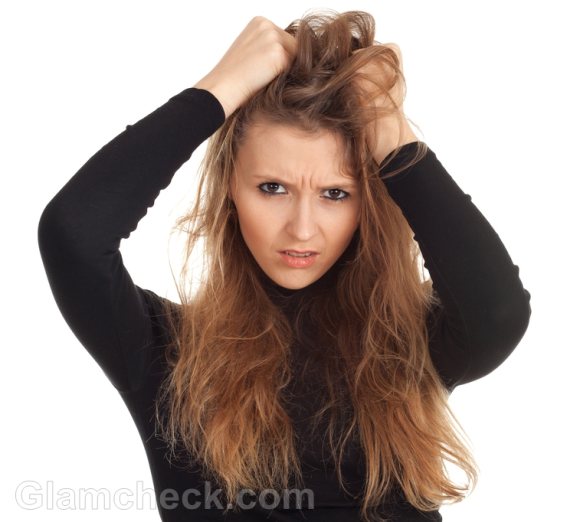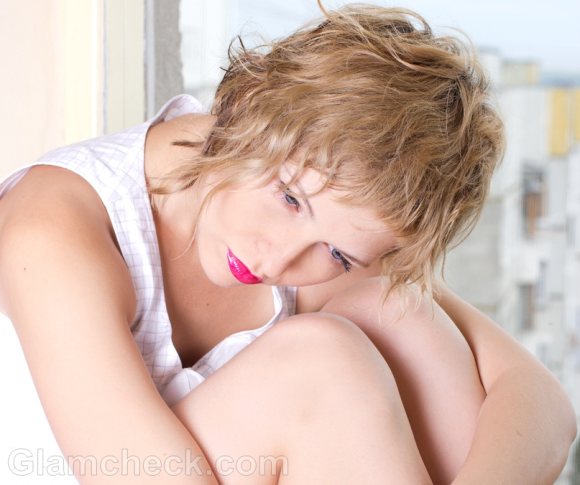Although classified as a hair loss condition, trichotillomania has more to do with psychological issues. Trichotillomania is characterized by a strong desire to pull, play and twist hair until it falls out. Although patients of trichotillomania can see the hair loss and know that it is happening, they cannot control their impulses and stop the hair-damaging behavior.
 Patients of trichotillomania do not localize their pulling to the hair on the scalp alone. The picking will occur on all areas of the body that are covered with hair such as the eyebrows, eyelashes, armpits, pubic area, chest, legs and arms.
Patients of trichotillomania do not localize their pulling to the hair on the scalp alone. The picking will occur on all areas of the body that are covered with hair such as the eyebrows, eyelashes, armpits, pubic area, chest, legs and arms.
The severity of trichotillomania will differ from person to person. Some patients may just need to concentrate a little or be made aware of what they are doing to bring their trichotillomania under control. Others may have a much harder time and will not be able to control their urges at all.
Trichotillomania Causes
The causes of trichotillomania are not really known or understood. Usually, an event can trigger the anxious habit of pulling on hair till it falls out or breaks. The patient may feel some relief from negative feelings, a sense of pleasure or satisfaction from the act. So the next time a stressful or negative situation arises that the patient is unable to cope with, they may resort to hair pulling to ease the intensity of negative emotions.
But the reasons that this kind of behavior begins is still being researched. Preliminary reports state that it could be genetic. Some studies suggest that there will not be just one cause that fits all but rather trichotillomania causes will differ on a case by case basis.
However, it is generally agreed that trichotillomania patients pull their hair out in an effort to self-soothe when they are deeply distrubed by something in their lives.
Symtpoms of Trichotillomania
Trichotillomania is more likely to affect younger people than older ones. In fact, trichotillomania can even begin in infants who are not even a year old. The symptoms of trichotillomania will usually manifest before the age of 17.
- Hair growth will appear uneven and patchy. A patient of trichotillomania may wear scarves, wigs, sun glasses or excessive makeup to hide the hair loss.
- Most patients of trichotillomania will deny that they are pulling out their own hair.
- Trichotillomania patients will often twist or twirl their hair, touch their hair when they are working, reading, talking on the phone, falling asleep, or just relaxing. Many people with trichotillomania will do their hair pulling in private, but it is not unheard of for patients to manifest this behavior in public as well without realizing it.
Trichotillomania has many psychological symptoms as well. This is something that the people around the patient should be on the lookout for since the patients themselves may not even be willing to admit that they have a problem.
- The patient suffering from trichotillomania may withdraw from social interaction, and in extreme cases may avoid any kind of human contact whatsover. They may go to great lengths to avoid people who will recognize their symptoms. For example, they may take a long-winded road to work so that they do not bump into a friend who knows about trichotillomania and will be able to tell that something is wrong.
- Trichotillomania can even interfere with daily functioning. Patients can spend hours pulling out their hair and this can come in the way of regular tasks. They may have very low levels of productivity because of this.
- Patients of trichotillomania often have very low self-esteem, and a poor self image. They may suffer from depression or acute anxiety, which further exacerbates their trichotillomania.
Impact of Trichotillomania
 Trichotillomania is not just about hair loss. It affects the patient on several levels, and can have a negative impact on the family as well.
Trichotillomania is not just about hair loss. It affects the patient on several levels, and can have a negative impact on the family as well.
Injuries
Any kind of repetitive motion, no matter how simple or small can cause repetitive motion injury to the muscles or parts of the body that are being used. Sufferers of trichotillomania tend to pull out hair in the same manner and from the same ares on the scalp. The repetitious behavior can cause injuries in the hands and shoulders which can make it difficult to move those parts without pain. Note though that the pain will not stop a trichotillomania patient from giving in to the urges.
Hair Swallowing
Trichotillomania can turn into a much more serious problem when the patient starts eating the hair that is being pulled out. Some patients will eat only the roots, while others will swallow whole hairs. This can lead to the creation of a hair ball which further leads to blockage in the intestines. The only way to get rid of it is through surgery. This is actually quite serious and can be fatal if not treated.
Effect on the Family
Trichotillomania does not just affect the individual; it has repercussions on the family and close friends of the patient as well. It’s not a good feeling to know that someone you care about and see every day is emotionally troubled. But more than a deep concern, families and friends can be ashamed or embarrased of the patient and not want to be seen with them. This in turn has an impact on the patient, making them isolate themselves even more, and leading to a drastic curtailment of work and social interaction.
Treatment for Trichotillomania
Trichotillomania is one of the more difficult hair loss conditions to treat since the causes are so hazy. But cognitive behavioral therapy and medication are the basic treatment options available.
Before treating trichotillomania, it must first be accurately diagnosed. A consultation with a dermatologist will be required to test an area of the scalp so as to rule out other causes of hair loss such as infection. Although a dermatologist can confirm and diagnose trichotillomania, other types of medical help will be required to treat the condition.
Cognitive Behavioral Therapy
With trichotillomania, the root of the problem has to be treated if there is to be any chance of success. So some kind of counseling must be incorporated into the treatment plan so that the cause of the behavior can be discovered.
But even more helpful than regular counseling sessions is cognitive behavioral therapy. This is a form of therapy that seeks to understand the triggers behind a certain behavior, and then find a way to alter the behavior associated with that particular trigger. This is especially helpful for patients for trichotillomania since even research points towards an emotional issue being the primary cause of the condition.
Cognitive behavioral therapy or CBT is based on a theory of learning which states that as we practice new thought patterns and behaviors, the neurons in the brain have to quite literally change their structure and create new pathways that allow the new behavior to become the automatic response to a trigger, thus replacing a destructive behavioral pattern.
Medication
Medication may be prescribed, but there is no consensus on the best medication for hair loss caused by trichotillomania. Drugs may create a whole host of other complications that have to be dealt with, which may be too much for the fragile emotional state of a patient of trichotillomania. So it may be best to just avoid medication altogether in the treatment of trichotillomania.
Suport Group
Although counseling is great and one of the key factors of treating trichotillomania, there’s nothing like having a support system made up of other people who are suffering from the same problem and who can relate to the emotional undercurrrents of trichotillomania. Since awareness of trichotillomania is still in its nascent stages, it may not be possible to find a support group nearby. However, there are several online support groups that have been started by medical professionals as well as concerned individuals which can provide much-needed support.
Stress Reduction
Reducing stress levels or finding ways to better manage stressful situations can also be of great help since stress can increase the incidence of urges and decrease the will power to stop the destructive behavior.
Alternative/Complementary Therapies
Yoga, dietary changes meditation, hypnosis and herbal remedies may be used alongside the above treatments for trichotillomania. Yoga and meditation can help reduce stress and calm the mind. Dietary changes can help to improve health and provide the body with the nutrition it needs to heal. And hypnosis has proven to be effective in altering behavior too, as many former smokers or alcoholics will testify.
If trichotillomania occurs before a child is 6 years of age, it is very likely that the condition will go away on its own without any interference or treatment. With many other people though, trichotillomania can be a frustrating and embarrasing form of an obsessive compulsive disorder that lasts a lifetime. There is no permanent cure for trichotillomania since the condition depends on the mental state of the patient, and a situation of great stress or psychological trauma can cause the behavior to start again even years after successful treatment.
Image: Shutterstock
